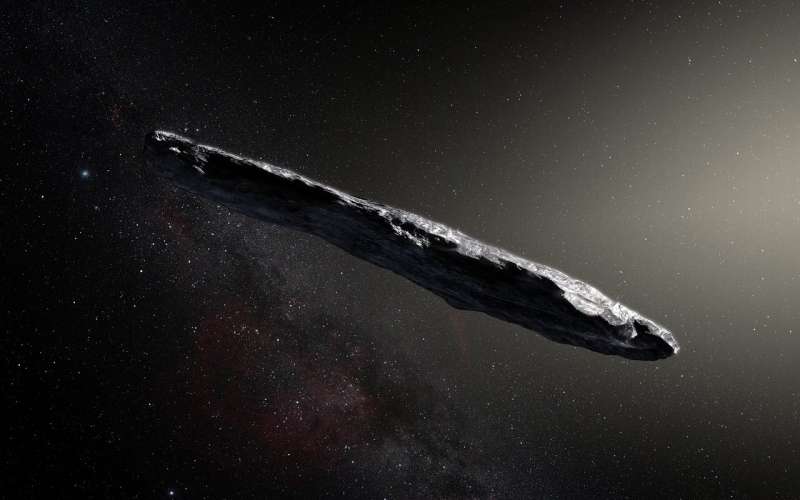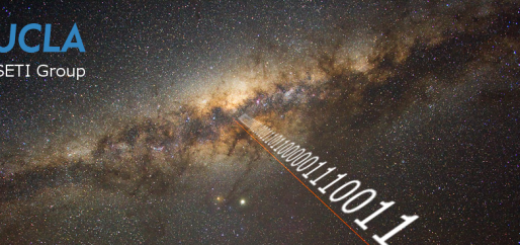When stars get too close to each other, they cast out interstellar comets and asteroids

In October 2017, humanity caught its first-ever glimpse of an interstellar object—a visitor from beyond our solar system—passing nearby the sun. We named it “Oumuamua, and its unusual properties fascinated and confounded astronomers. Less than two years later, amateur astronomer Gennady Borisov found a second interstellar object: a comet-like body that began to disintegrate as it passed within 2 AU of the sun (1 AU equals the distance from Earth to the sun). Where do these interstellar objects come from? How common are they? With a sample size of just two, it’s difficult to make any generalizations just yet. On the other hand, given what we know about star formation, we can begin to make some inferences about the likely origins of these objects, and what we are likely to see of them in the future.
One of the most likely culprits for ejecting asteroids and comets into interstellar space is close encounters between stars. Four researchers studying this question—Susanne Pfalzner, Luis Aizpuru Vargas, Asmita Bhandare, and Dimitri Veras—released a paper last week examining this process.
When stars get too close to each other, they can cause gravitational interactions that wreak havoc on the stars’ orbiting bodies. As the researchers explain, “such close flybys happen most frequently during the first 10 million years of a star’s life.” This is because stars tend to form close together in clusters, born collectively from enormous clouds of gas. During this turbulent early period of their life, stars can approach each other and rip tiny planetesimals out into deep space in the process, leaving them alone as wayward travelers in the night. Not all stars experience such violent interactions. It tends to be a small subset of stars that eject most of the interstellar objects.
When these interactions do occur, the mass of the stars involved matters a great deal. High-mass stars that come within 250AU of each other can rip away so much material that more than half of a system’s planetesimals might be turned into interstellar objects, leaving little behind in orbit around the parent star.
The second interstellar object ever discovered passing through our solar system, 2I Borisov, in October 2019. Credit: NASA, ESA, and D. Jewitt (UCLA)
The researchers were also able to predict the expected velocities of ejected objects, and perhaps most interestingly, their composition. Asteroids tend to form closer to their star, with comet-like objects further out. The comets are therefore more susceptible to ejection, meaning that most interstellar objects likely look more like Borisov and less like “Oumuamua, which had asteroid-like properties.
There are other processes that can eject planetesimals, too. Interactions with giant planets like Jupiter, for example, can throw asteroids out into deep space. We might be able to tell which method ejected an individual object by its speed—planetary scattering tends to create faster-moving objects, while stellar interactions produce slower-moving ones.
“Oumuamua was very slow, making stellar interaction a likely source. Planetary scattering, on the other hand, can’t be ruled out for the faster-moving Borisov.
The paper also produced a fascinating result concerning our own solar system: it probably ejected about 2-3 Earth masses worth of material out into deep space during the formation of our star. That means that while we sit waiting for the next “Oumuamua or Borisov to visit us, our own interstellar comets and asteroids are out there now, visiting alien worlds and distant suns.



 Creators of mankind
Creators of mankind Description of “Tall white aliens”
Description of “Tall white aliens” Where they came from?
Where they came from? About hostile civilizations
About hostile civilizations The war for the Earth
The war for the Earth “Tall white aliens” about eternal life
“Tall white aliens” about eternal life Video: “Nordic aliens”
Video: “Nordic aliens” Aliens
Aliens Alien encounters
Alien encounters The aliens base
The aliens base UFO
UFO Technology UFO
Technology UFO Underground civilization
Underground civilization Ancient alien artifacts
Ancient alien artifacts Military and UFO
Military and UFO Mysteries and hypotheses
Mysteries and hypotheses Scientific facts
Scientific facts


















